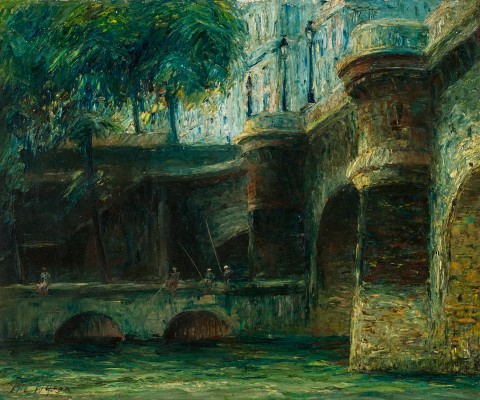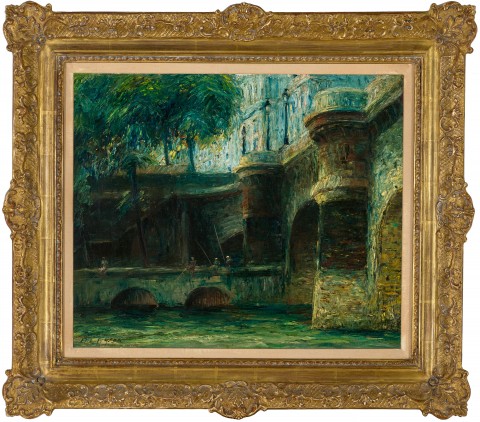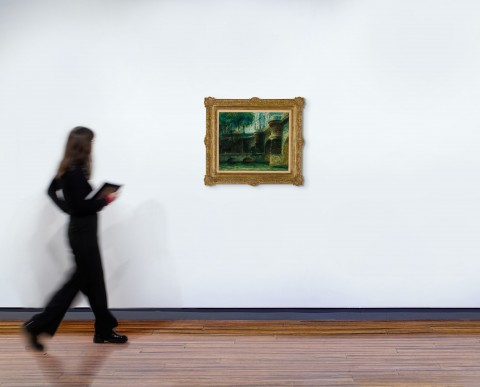PONT NEUF, c.1939
ERIC WILSON
oil on canvas
51.0 x 61.5 cm
signed lower left: Eric Wilson
Sir Keith Murdoch, Melbourne
A collection of Antiques: The Property of Sir Keith and Lady Murdoch from their former residence ‘Heathfield’, Toorak, Decoration Co. Pty. Ltd., Melbourne, 20 August 1947, lot 220 (as ‘Pont de Neuf’)
Private collection
Joseph Brown Gallery, Melbourne
Possibly Ted Lustig, Melbourne
Eastgate & Holst, Melbourne
Private collection, Melbourne, acquired from the above in 2004
Eric Wilson Memorial Exhibition, National Art Gallery of New South Wales, Sydney, 28 May – 29 June 1947, cat. 34 (lent by Sir Keith Murdoch)
Spring Exhibition 1975, Joesph Brown Gallery, Melbourne, 14 – 30 October 1975, cat. 44 (illus. in exhibition catalogue)
Collectors 2004 Exhibition, Eastgate & Holst, Melbourne, 21 July - 11 August 2004, cat. 56
Pont Neuf, 1945, oil on paper on hardboard, 48.5 x 61.5 cm, in the collection of the Art Gallery of New South Wales, Sydney
Pont Neuf, Paris, c.1945, oil on board, 41.0 x 51.0 cm, private collection
Hailed by Douglas Dundas as ‘one of the bright stars in the firmament of Australian art during the 1940s’1, Eric Wilson is remarkable for having achieved widespread success not only as an abstractionist (whose still-lifes represented some of the first experiments in Cubism by an Antipodean artist), but equally, as a modern realist painter of European cityscapes – impressively exemplified here by Pont Neuf, c.1939.
Awarded the New South Wales Travelling Art Scholarship in 1937, Wilson accordingly embarked for England in June the same year, studying first briefly at the Royal Academy before enrolling at the more progressive Westminster School under British modern painters, Mark Gertler and Elmslie Owen. The latter was especially influential, urging the young artist to proceed in the vein of the French avant-garde ‘according to knowledge rather than mere vision’2, and encouraging Wilson to pursue his cubist explorations further at Amedée Ozenfant’s Academy in Earl’s Court. In the early months of 1939, Wilson departed London for the Continent where he travelled and sketched in Belgium, the Netherlands and Italy, absorbing, among other things, that sense of rounded volumetric form so revered in the work of Italian Quattrocentro primitives such as Piero della Francesca. Above all though, it was the city of Paris that inspired Wilson most – ‘not the large-scale vistas of the master-planned metropolis… but the more intimate curves and corners of narrow streets, and tree-lined quays of the Seine’3 – and thus, he spent hours capturing en plein air the picturesque streets and majestic bridges in drawings that would later provide the basis for his celebrated series of Paris cityscapes undertaken upon his return to Australia in late 1939 following the outbreak of World War II.
Immortalising the oldest and arguably most iconic bridge in Paris with its noble arches linking the Île de la Cité to both the left and right banks, the present work encapsulates superbly Wilson’s earlier explorations of the Paris theme that are distinguished by an underlying sense of construction and careful attention to composition and architectural form. Indeed, as Wilson’s experience of Europe grew more distant in time later iterations such as By the Seine, c.1945 (Mr and Mrs Crebbin collection) or Pont Neuf, 1945 (Art Gallery of New South Wales) by contrast evidenced a much looser treatment and a greater preoccupation with impressionistic effects of light and colour – leading one critic in 1947 to disparagingly remark upon the ‘heavy cookery’4 of these late works, citing their use of thick impasto and absence of formal definition. Resonating throughout all Wilson’s pensive European landscapes however, including Pont Neuf, is a pervading sense of isolation, of the artist as outsider – a feeling perhaps derived from the impending war which had precipitated his trip in the first place, and which no doubt prevented him from stepping outside the role of tourist. The invariably wet and chilly vignettes are either disconcertingly empty, or when peopled – as is the case here with the fishermen scattered along the embankment – such figures remain oblivious of the artist, continuing the closed activities of their daily lives. In this respect, Wilson’s perspective contrasts starkly with that of his artistic peer, William Dobell, with whom he lived and studied in London. For where Dobell found the inhabitants of a city such as Paris or London much more intriguing and typical than their surroundings, Wilson concentrated rather upon the streetscapes and buildings as his subjects, discerning in the architecture the unique character he was seeking.
1. Dundas, D., ‘Eric Wilson’, Art in Australia, vol. 12, no. 1, July – September 1974, p. 48
2. Diary of the artist, 2 June 1938 cited in Sayers, A., ‘Introduction’, Eric Wilson, exhibition catalogue, Newcastle Regional Art Gallery, Newcastle, 1983, p. 9
3. Dundas, op. cit., p. 56
4. ‘Wilson And Elyard Exhibitions’, Sydney Morning Herald, Sydney, 28 May 1947, p. 9
VERONICA ANGELATOS


